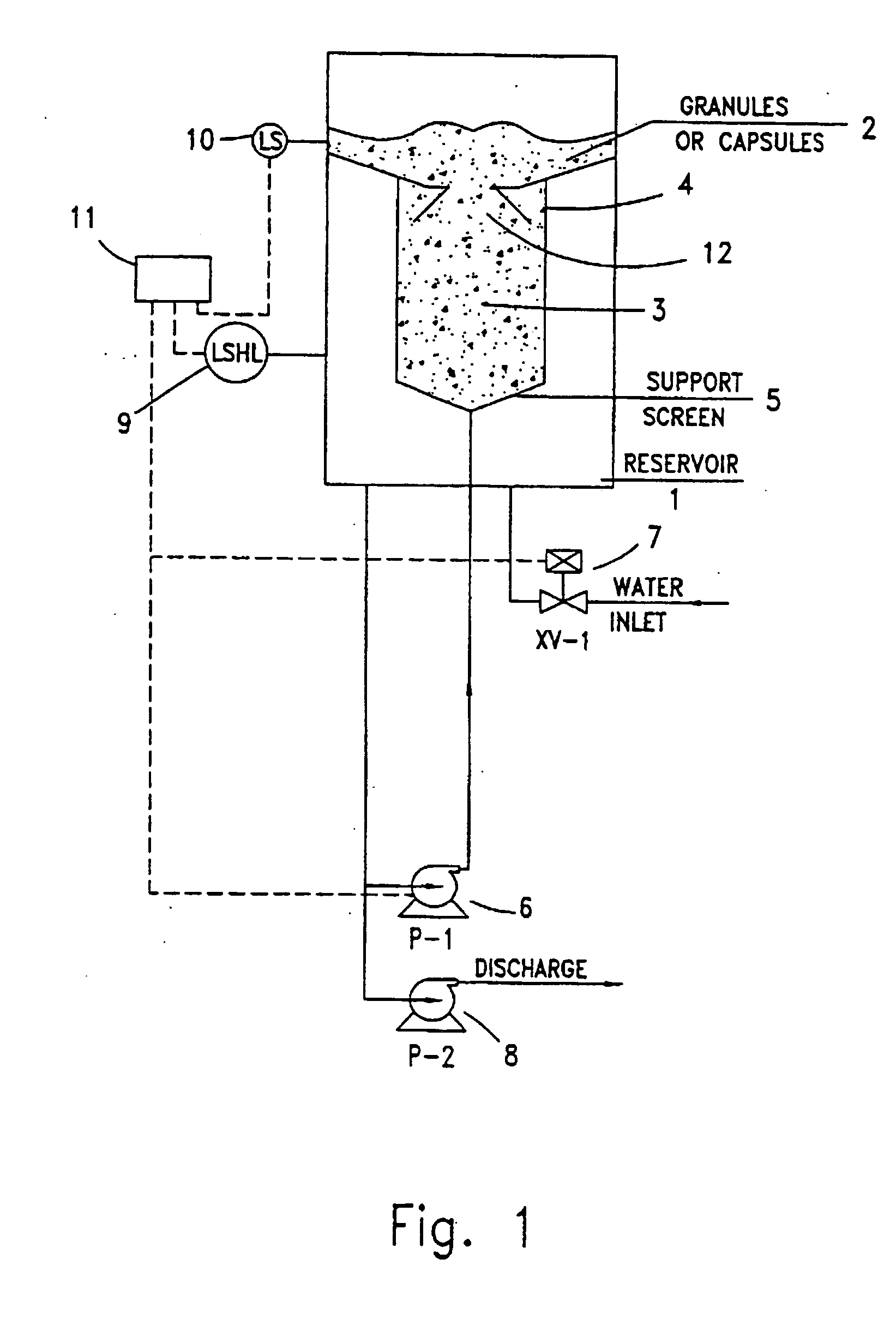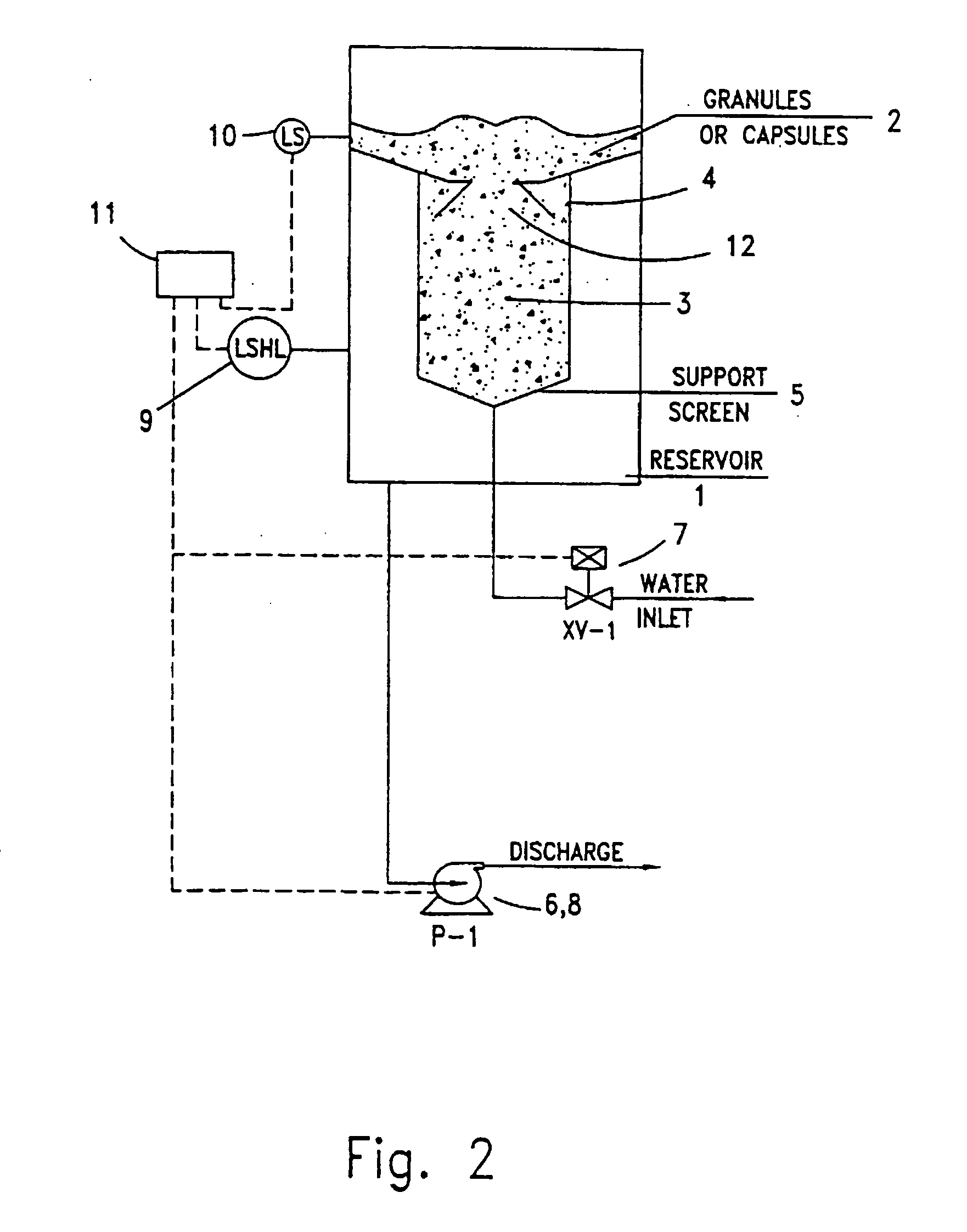Solid material dissolution apparatus
a technology of solid materials and dissolution apparatuses, which is applied in the direction of dissolving, settling tank feed/discharge, chemical/physical processes, etc., can solve the problems of inconsistency in biocide concentration, inability to prepare biocide solutions, and inability to meet the requirements of solid biocide based solutions,
- Summary
- Abstract
- Description
- Claims
- Application Information
AI Technical Summary
Benefits of technology
Problems solved by technology
Method used
Image
Examples
example 1
Comparing DBNPA Concentrations in Solutions Prepared by a Conventional Dosing Apparatus and the Present Invention
[0066] FIG. 3 presents the concentration of 2,2 Dibromo-3-nitrilopropionam-ide (DBNPA) in the outlet of a "conventional" dissolution apparatus as a function of time. The solid material was dissolved by passing water at a flow rate of 100 l / hour.
[0067] As can be seen, with the progression of time, DBNPA concentrations at the outlet of the apparatus decrease substantially resulting in a varying solution concentration.
[0068] FIG. 4 describes the concentration of DBNPA in solutions prepared by the dissolution apparatus of the present invention during an actual operation trial lasting for 1 month. The solutions (a volume of 10 liters each) were prepared once a day and the DBNPA concentration was determined prior to discharge.
[0069] As can be seen, the DBNPA concentrations were stable, regardless of the amount of solid biocide in the apparatus. This may be compared to FIG. 3 wh...
example 2
A Mode of Operation of the Apparatus--A Case Study and Field Trial
[0070] The performance of the dissolution apparatus according to the present invention was demonstrated for the application of a non-oxidative biocide e.g. 2,2-dibromo-3-nitrilopropionamide (DBNPA).
[0071] (A) Test Site: The test was conducted in a cooling tower located on the shores of the Mediterranean Sea. The 8 m.sup.3 cooling tower has a daily makeup of approximately 20 m.sup.3, and a concentration ratio that ranged between 6-10. Typical pH values for the cooling water ranged from 8.5-8.8. A portion of the re-circulated water was filtered through a disk filter. The ambient temperatures during the trial were 25-30.degree. C.
[0072] (B) Device Operation:
[0073] 1. Installation:
[0074] 1.1 The apparatus was placed within 2 meters of the treated tower.
[0075] 1.2 The apparatus was secured firmly to prevent tilting during operation.
[0076] 1.3 The apparatus was connected to a water main (as a water source), to a power sourc...
example 3
Operation of the Apparatus in a Continuous Mode
[0095] The solid biocide dissolution system was operated continuously in accordance with the previously described mode of continuous operation. The system was operated with varying flow rates and the results were as follows:
1 DBNPA concentration Flow (l / h) (mg / l) 50 16725 .+-. 277 75 15075 .+-. 433 100 14870 .+-. 843 150 14535 .+-. 1661 200 12190 .+-. 1348 250 12270 .+-. 986 300 10981 .+-. 602
[0096] The results represent an average of 5 samples drawn within 30 minutes of operation at the designated flow.
[0097] The foregoing disclosure and description of the invention is merely illustrative and explanatory thereof. Various changes in the details of the illustrated configuration and mode of operation may be made by a person skilled in the art within the scope of the invention, without departing from the true spirit of it. Thus, the same principle and outcome can be obtained with other combinations of pumps, venturi based devices and contr...
PUM
| Property | Measurement | Unit |
|---|---|---|
| Flow rate | aaaaa | aaaaa |
| Concentration | aaaaa | aaaaa |
| Dimension | aaaaa | aaaaa |
Abstract
Description
Claims
Application Information
 Login to View More
Login to View More - R&D
- Intellectual Property
- Life Sciences
- Materials
- Tech Scout
- Unparalleled Data Quality
- Higher Quality Content
- 60% Fewer Hallucinations
Browse by: Latest US Patents, China's latest patents, Technical Efficacy Thesaurus, Application Domain, Technology Topic, Popular Technical Reports.
© 2025 PatSnap. All rights reserved.Legal|Privacy policy|Modern Slavery Act Transparency Statement|Sitemap|About US| Contact US: help@patsnap.com



